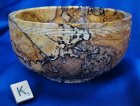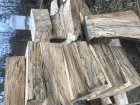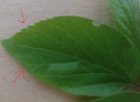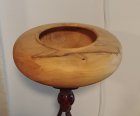My neighbor is cutting several trees at the back of his lot. One is some type of cherry which I'm going to pick up a few pieces- love to turn cherry. The other has a real light wood which he said was hackberry. Worth drying and turning? Thanks.
-
It's time to cast your vote in the April 2025 Turning Challenge. (click here for details) -
Congratulations to Steve Bonny for "A Book Holds What Time Lets Go" being selected as Turning of the Week for 28 April, 2025 (click here for details) -
Welcome new registering member. Your username must be your real First and Last name (for example: John Doe). "Screen names" and "handles" are not allowed and your registration will be deleted if you don't use your real name. Also, do not use all caps nor all lower case.
You are using an out of date browser. It may not display this or other websites correctly.
You should upgrade or use an alternative browser.
You should upgrade or use an alternative browser.
Turning hackberry?
- Thread starter John Torchick
- Start date
- Joined
- Apr 27, 2004
- Messages
- 9,162
- Likes
- 5,769
- Location
- Lakeland, Florida
- Website
- www.hockenberywoodturning.com
other has a real light wood which he said was hackberry. Worth drying and turning? Thanks.
great for bowls and HF.
Rough out the bowls for drying.
or single turn HFs or NE bowls.
you could dry some 3x3 for ornament balls.
The wood database can be a little dry, but they do have pictures of most woods, as well as data on hardness, etc. The hackberry I've seen for sale has generally been advertised as nearly white.
https://www.wood-database.com/hackberry/
https://www.wood-database.com/hackberry/
If you can get it to spalt, it looks wonderful. I met a old(er) turner a year ago at a show who had many spalted hackberry bowls that were spectacular.
If you can get it to spalt, it looks wonderful. I met a old(er) turner a year ago at a show who had many spalted hackberry bowls that were spectacular.
It spalts beautifully and easily. Most of the freshly cut hackberry I've gotten has spalted on its own quickly, usually in a matter of weeks.
That's good to know, I've got a couple of hackberry trees that are next on my harvest queue.
Spalts easily, cuts well. Good wood. Easy to tell if it's Hackberry. Look at the bark. If it has warts all over it's Hackberry.
I've turned a few bowls made from spalted hackberry......turns very easily, and looks good. Without the spalting, it can be rather plain grained, though........If you can get it to spalt, it looks wonderful. I met a old(er) turner a year ago at a show who had many spalted hackberry bowls that were spectacular.

odie and charlie, like your turnings! OK, next- how do you get it to spalt???? Again, thanks.
I’ve never had any hackberry but I’ve been spalting maple for 25 years. I get the best results if I keep the log off the ground and just let it sit. For silver maple it’s from 6 to 12 months, for red maple it’s 12-18 months. For sugar maple it’s 16-24 months. These times are for a freshly cut healthy tree. Damaged or dying trees have already started the process so the time can be much less. I’ve read others say they let the log sit on the ground, it will spalt faster but I find with any maple I get more punky wood if I let it sit directly on the ground. When I see the bark is starting to come loose I cut a few inches off the end and check the progress. Timing is important, it will go from just right to too soft in a short period. The softer the wood the faster this will happen, silver maple is pretty soft and will go from barely spalted to rotten in a couple of months in the summer.odie and charlie, like your turnings! OK, next- how do you get it to spalt???? Again, thanks.

A wonderful wood to turn. Lots of sapwood, but combining heartwood can be very dramatic. Nothing plain about it in my book. You have to watch the color if you do try to spalt it. Just partially there and you loose the wonderful crisp cream color, and get a muddy gray. No spalting in this piece, that was the natural heart coloring.
Attachments
I've turned a bit of "hackberry", which indeed spalts quickly. I grew up in middle TN, where it was prevalent, though I think that was common hackberry (celtis occidentalis). Now I'm just south of Houston TX where people call it sugarberry (celtis laevigata) and even though it looks the same to me, it seems to have a stronger odor. After roughing out a few bowls my shop smells like a barn for a couple of days, a strong urine odor. Eventually it fades away though. It also has a tendency to quickly splotch unattractive grey spots, though I suspect that has something to do with the heat and humidity here...
Greg's reply is interesting. I might not live long enough to turn it. I don't even buy green bananas. Might just rough turn, let it sit inside to dry and go from there. Even without spalting, I like the fine grain.Thanks to all.
Never smelled that in hackberry. Cottonwood, and elm, but not hackberry.I've turned a bit of "hackberry", which indeed spalts quickly. I grew up in middle TN, where it was prevalent, though I think that was common hackberry (celtis occidentalis). Now I'm just south of Houston TX where people call it sugarberry (celtis laevigata) and even though it looks the same to me, it seems to have a stronger odor. After roughing out a few bowls my shop smells like a barn for a couple of days, a strong urine odor. Eventually it fades away though. It also has a tendency to quickly splotch unattractive grey spots, though I suspect that has something to do with the heat and humidity here...
I had a piece of hackberry on the shop floor and it spaulted right there in just a few weeks
I had a piece of hackberry on the shop floor and it spaulted right there in just a few weeks
Indeed. If the piece has much moisture in it, it is just about impossible to keep it from spalting quickly. It can get quite dramatic, but then it can go on to punky relatively quickly, so you have to keep an eye on it. To get the pristine near-white color, you need to get it turned and drying soon after cutting.
- Joined
- Jan 27, 2005
- Messages
- 13,098
- Likes
- 5,557
- Location
- Dalworthington Gardens, TX
- Website
- pbase.com
I've turned a bit of "hackberry", which indeed spalts quickly. I grew up in middle TN, where it was prevalent, though I think that was common hackberry (celtis occidentalis). Now I'm just south of Houston TX where people call it sugarberry (celtis laevigata) and even though it looks the same to me, it seems to have a stronger odor. After roughing out a few bowls my shop smells like a barn for a couple of days, a strong urine odor. Eventually it fades away though. It also has a tendency to quickly splotch unattractive grey spots, though I suspect that has something to do with the heat and humidity here...
I have a Texas Sugarberry tree in my back yard. You can easily identify the difference between it and Common Hackberry by looking at the leaves and the bark. The leaf edges on the Sugarberry are smooth while the common hackberry leaves are sharply serrated. The bark on the common hackberry tends to get very rough as the tree matures while the Sugarberry bark is smooth with scattered clusters of rough nodules. Here is some information on Sugarberry from Texas A&M: Sugarberry
Here is information on the common hackberry.
Bill, advised not to open those links as being unsecured, if that's a word. I have a HB in my yard, will look as the leaves are starting to come out.
- Joined
- Jan 27, 2005
- Messages
- 13,098
- Likes
- 5,557
- Location
- Dalworthington Gardens, TX
- Website
- pbase.com
Bill, advised not to open those links as being unsecured, if that's a word. I have a HB in my yard, will look as the leaves are starting to come out.
I did an April Fool just for you, John. Try it again and you will get the Texas A&M University Forest Service web site. There is nothing to fear about an unsecure connection to a website as long as you aren't conducting financial transactions or revealing all your personal secrets.
We had a terrible tragedy here today. A local TV station reported that an 18 wheeler rolled over and caught fire. And the worst part of this tragedy is that it was carrying a load of toilet paper. The on-the-scene reporter was overcome with emotion. Oh, the humanity. (4-1-20)
. Oh, the humanity. (4-1-20)
Bill you have been a "Baaaaad boy" Lou Costello
So a truckload of toilet paper wiped out? Bet it was a moving time for the reporter.
I have a Texas Sugarberry tree in my back yard. You can easily identify the difference between it and Common Hackberry by looking at the leaves and the bark. The leaf edges on the Sugarberry are smooth while the common hackberry leaves are sharply serrated.
Perhaps I have hybrid trees here then, because the bark looks identical to common hackberry as far as I can tell, and the leaves, well the leaves are a bit of both. Most have one smooth side (like sugarberry) while the other side shows serrations near the tip (not the base). And interestingly enough, of the several dozen leaves I examined, all of them had the serrations on the same side of the leaf, in the same location, across multiple different trees. Pic included.

- Joined
- Jan 27, 2005
- Messages
- 13,098
- Likes
- 5,557
- Location
- Dalworthington Gardens, TX
- Website
- pbase.com
OK, so you have a sugarhack. 

Here's the retailer's listing for hackberry, where I've most commonly seen it. Obviously, you're not in a market to buy, so this is just for informational purposes. https://www.turningblanks.net/collections/hackberry?mc_cid=9510363fe9&mc_eid=cfeb22b5bc
(disclaimer: I have no financial interest in this company, but have been a satisfied customer.)
(disclaimer: I have no financial interest in this company, but have been a satisfied customer.)
Dean, thanks for the info. Neighbor has a huge stack of HB and some kind of cherry. Our chapter meeting for this month has been cancelled. Will pick a couple of pieces for our wood lottery- fund raiser for us.



